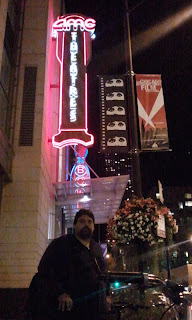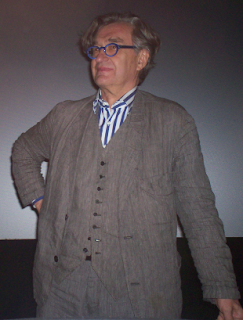10/18 -
She developed a unique phenomenology of gestures,
a view of the world, so to speak, or even better:
an explanation or interpretation of our humanity
that was wholly new and unexplored.
-Wim Wenders, on September 4, 2009,
at the memorial ceremony for Pina Bausch
in the Wuppertal Opera House
 |
| Pina Bausch photographed by Donata Wenders, 2004 |
Without a doubt, the highlight of the Chicago International Film Festival was
Wim Wenders' presentation of his 3-D tribute to the life and work of renowned choreographer,
Pina Bausch. Before the CIFF screening of
Pina, Wim Wenders gave an eloquent introduction for his new film that detailed the arduous journey of the nearly abandoned project. Twenty years in the making, Wenders had communicated numerous times with Bausch about making a dance film, but, even after viewing every dance film he could get his hands on, he was not only dissatisfied with all past portrayals of dance on film, but confounded about how to capture the brilliance of Bausch's work in one of his own. Then, Wenders told us, he saw a film that brought all of his ideas into the light. Although he found the title inelegant,
U2 3D was an unexpected catalyst for his thinking about the collaboration with Brausch, and he was on the phone to Bausch before the credits were done rolling. "I know how to do it," he said to her. Unfortunately, Bausch died at 68 years old, only days after she was diagnosed with cancer, and just before the film was to go into production.
I hesitate to attach the descriptor "3-D" to Wender's extraordinary film, given the climate of the current commercial cinema as it desperately tries to sell every weak-scripted product to a mass audience through the use of 3-D, defiling a technology that, as we see in such rare glimpses, can be used to astonishing affect. Although "3-D" is entirely accurate and necessary here, the term itself seems to have been dragged through the mud. I have commented on the empty use of 3-D technology a number of times on this site, but seeing a film like
Pina reminds me anew how carelessly the technique of shooting in this format has been used over the last decade (and, trust me, I've seen a lot of them, from the animated features to the horror splatter-fests). With the majority of 3-D movies, the 3-D process often being applied in post-production as more of a marketing tool than an aesthetic one, the "effect" usually starts out very strong, eventually drifting away from it's capacity to "wow" the audience by halfway into the picture. And, why shouldn't it? Everything else in our lives is 3-dimensional, so how long can the thrill really be expected to last inside the cinema, especially when nobody took the care to make the images meaningful in their two dimensional state? As far as my experience is concerned, I have seen only three films that grasp the potential for 3-D cinema: Werner Herzog's
Cave of Forgotten Dreams, the Nasa produced
Hubble 3D (not a great film in it's writing or construction, but a mind-blowing 3D experience of time and space travel)
, and, now, Wim Wenders'
Pina.
 |
| Pina |
Wenders was inspired to complete his film by the dancers who lived on with Bausch's work in their bodies. The way in which he documents Bausch's dancers is brilliant, always contrasting a candid, intimate close up of each member with a voice over of them expounding on Bausch's influence. Wenders then contrasts the stillness of these portraits with dance scenes that pay tribute to Bausch through each individual dancer, often set in stunning outdoor locations, or within interiors that, through the poetic use of Wenders' camera, become part of the dance in his stereoscopic vision. Also on display here are longer passages from the most memorable of Bausch's work: "The Rite of Spring," "Cafe Mueller," "Kantakthof," and "Vollmond." It is within these ensemble stage pieces that we feel the full power of Bausch's choreography, and begin to believe that Wenders was, indeed, correct: this is a film that needed to be in 3D.
Prior to the screening, Wenders told us that
Pina is not a sad film. But, if there is one criticism I can make of
Pina, it is that it is difficult to see through 3D glasses when you are weeping. And, no, the film is not sad, and the tears were tears of absolute wonder. Wenders told us after the screening that back in the 80's he had no interest in dance whatsoever. But, once he saw Bausch's work, the weight of what he was seeing expressed was, for him, revelatory. Particularly, what Bausch's work expressed to him about relationships between men and women was more revealing and insightful than every movie he had seen up until that point combined, he told us.
Pina shows in Wenders' work the careful and intent gaze that was supposedly Pina's trademark as a director, as he allows the life and work of his dear and talented friend to live on through this breathtaking document.
My personal love of dance feels strikingly similar to what Wenders described in his Q&A that evening. What can be captured about the human condition through the basic elements of motion and space, beyond language, blows me away in very much the same way he expressed, and so fully communicates through this film. I can say the same for the great movement and spaces of Wender's films, which continue to inspire with the same potency as when I first encountered them. Without
Kings of the Road,
Wings of Desire,
Paris, Texas...the list goes on...I wouldn't see the world in the same way that I do today. I thank the CIFF for allowing us to engage with Wenders, and for giving me the opportunity to thank this tremendous director for is work.
 |
| Wim and I at the CIFF |
Up Next: Zaida Bergroth's Gold Hugo Winner in the New Directors category at the CIFF,
The Good Son.

















































